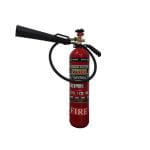Your list is empty, add products to the list to send a request
Types of Valves Used in Fire Fighting System

17
Feb
In any fire protection system, valves play a crucial role in controlling water flow, pressure, and direction to ensure effective fire suppression. Choosing the right type of valve can make a significant difference in the efficiency of a fire fighting system. Many professionals and property owners often struggle to understand which valves are essential and how they function.
In this guide, we will break down the different types of valves used in fire fighting systems, their applications, and how they contribute to fire safety. Whether you’re looking for an Ultra Fire SS Single Way Landing Valve, a Two Way Breeching Inlet CI Body Ultra Fire, or specialized NRV (Non-Return Valves) like Fortune Four Way NRV Fire Brigade-SS and Fortune Three Way NRV Fire Brigade-SS, you’ll find all the essential details here.
Let’s dive into the types of fire fighting valves and their functions.
1. Landing Valves in Fire Fighting Systems
Landing valves are an essential part of a fire hydrant system. They are designed to provide a controlled water supply for fire fighting operations.
1.1 Ultra Fire SS Single Way Landing Valve
The Ultra Fire SS Single Way Landing Valve is a high-quality stainless steel valve that is commonly installed in fire hydrant systems. It allows firefighters to connect their hoses quickly and access water under high pressure.
Key Features:
- Made of stainless steel (SS) for durability and corrosion resistance.
- Provides a reliable and quick water supply for fire emergencies.
- Used in commercial buildings, industrial sites, and residential complexes.
2. Breeching Inlet Valves for Fire Fighting
Breeching inlets allow external fire services to pump water into a building’s fire protection system, especially in high-rise structures. These inlets are essential for ensuring that water reaches upper floors quickly.
2.1 Two Way Breeching Inlet CI Body Ultra Fire
The Two Way Breeching Inlet CI Body Ultra Fire is a cast iron (CI) valve designed to enable firefighters to connect hoses easily and supply water into the building’s fire suppression system.
Key Features:
- Made of durable cast iron for longevity.
- Provides two connections for efficient water supply.
- Used in high-rise buildings, hospitals, and commercial properties.
Real-World Application:
During a fire emergency in a multi-story office building, firefighters connect their hoses to the Two Way Breeching Inlet CI Body Ultra Fire, ensuring that water is supplied to the upper floors where it is needed most.
3. Non-Return Valves (NRV) in Fire Fighting
Non-Return Valves (NRVs) ensure that water flows in one direction and prevents backflow. These valves are critical in maintaining the efficiency of fire fighting systems.
3.1 Fortune Four Way NRV Fire Brigade-SS
The Fortune Four Way NRV Fire Brigade-SS is a four-way non-return valve that ensures water flows smoothly to fire fighting equipment without the risk of backflow.
Key Features:
- Stainless steel construction for durability.
- Four-way connection allows multiple hose connections.
- Prevents water from flowing backward, ensuring a steady supply.
3.2 Fortune Three Way NRV Fire Brigade-SS
The Fortune Three Way NRV Fire Brigade-SS functions similarly to the four-way version but has three connection points instead. It is used in smaller setups or areas with limited space.
Key Features:
- High-strength material for reliability.
- Three-way configuration allows efficient water distribution.
- Prevents backflow, maintaining system integrity.
Real-World Application:
In a fire emergency, multiple hoses are connected to the Fortune Four Way NRV Fire Brigade-SS, ensuring a continuous water flow without the risk of pressure loss due to backflow.
4. Importance of Valves in Fire Fighting Systems
Fire fighting valves, including landing valves, breeching inlets, and NRVs, ensure that water is supplied efficiently in emergencies. They help in:
- Quick Water Access: Ensuring water reaches fire hoses instantly.
- Backflow Prevention: Keeping water flow consistent and preventing pressure drops.
- Durability: Made from high-quality materials like stainless steel and cast iron for long-term use.
- Compatibility: Designed to integrate seamlessly into fire suppression systems.
5. Choosing the Right Fire Fighting Valve
When selecting fire fighting valves, consider the following:
- Material: Stainless steel is best for durability, while cast iron is cost-effective.
- Application: High-rise buildings require breeching inlets, while hydrant systems need landing valves.
- Size and Capacity: Ensure compatibility with your existing fire suppression system.
- Regulations: Choose valves that comply with local fire safety regulations.
For top-quality fire fighting system materials, visit Firesupplies, your trusted source for high-performance fire protection products.
6. FAQs About Fire Fighting Valves
Q1: What is the purpose of a landing valve in a fire fighting system?
A landing valve provides a direct water supply to firefighters for quick fire suppression.
Q2: How does an NRV (Non-Return Valve) help in fire safety?
NRVs prevent backflow, ensuring a continuous and reliable water supply during emergencies.
Q3: Why is stainless steel preferred for fire fighting valves?
Stainless steel is corrosion-resistant, durable, and provides long-lasting performance.
Q4: What is the difference between a two-way and four-way breeching inlet?
A two-way breeching inlet has two hose connections, while a four-way version allows four hoses to be connected, providing greater water flow.
Conclusion
Fire fighting valves play a crucial role in ensuring an efficient and reliable fire suppression system. Whether you need an Ultra Fire SS Single Way Landing Valve, a Two Way Breeching Inlet CI Body Ultra Fire, or NRVs like the Fortune Four Way NRV Fire Brigade-SS, selecting the right valve is essential for fire safety.For top-quality fire fighting products, including landing valves, breeching inlets, and NRVs, visit Firesupplies, your go-to provider for fire safety gear and fire fighting system materials. Stay prepared and ensure your fire protection system is always ready for action.


























